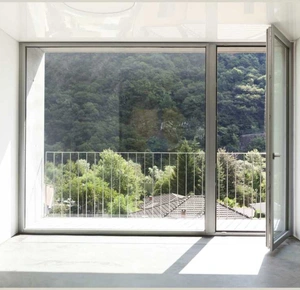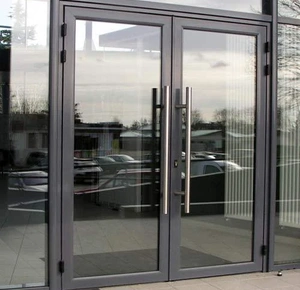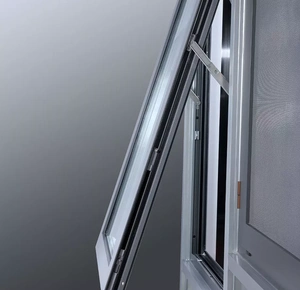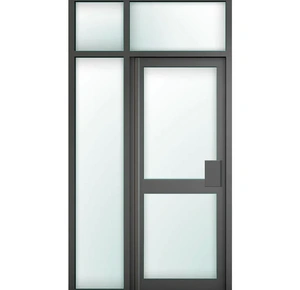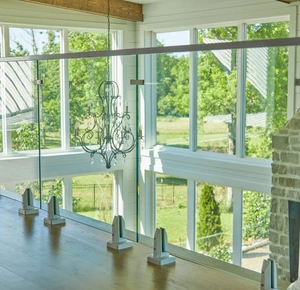Aluminum Doors with Thermal Break: A Comprehensive Guide
Aluminum doors are a popular choice in modern architecture due to their sleek design, durability, and lightweight structure. However, one of the biggest challenges with traditional aluminum doors is their high conductivity, which allows heat to easily pass through the frame, leading to significant energy loss. This is where aluminum doors with thermal break come into play.
By incorporating a thermal break into the design, these doors become highly energy-efficient, reducing heat transfer, improving insulation, and offering better overall comfort. In this article, we’ll explore the concept of thermal breaks in aluminum doors, their benefits, how they work, and why they are an excellent investment for both residential and commercial properties.
1. What is a Thermal Break in Aluminum Doors?
A thermal break refers to an insulating barrier placed between the interior and exterior sections of an aluminum door frame. This barrier is typically made from non-conductive materials such as polyamide or polyurethane. The purpose of the thermal break is to prevent the transfer of heat from the outside to the inside of the building (and vice versa), improving the energy efficiency of the door.
Aluminum is a highly conductive material, meaning it transfers heat and cold very efficiently. Without a thermal break, aluminum doors can easily allow heat to escape during the winter and let in hot air during the summer, resulting in increased energy consumption to maintain indoor temperatures.
2. How Does a Thermal Break Work?
A thermal break works by interrupting the flow of heat through the aluminum frame. In a traditional aluminum door without a thermal break, heat travels easily from one side of the frame to the other because aluminum is a good conductor. This leads to heat loss in winter and unwanted heat gain in summer.
In an aluminum door with a thermal break, an insulating material is inserted between the interior and exterior parts of the frame. This break creates a barrier that blocks the conduction of heat, thus reducing the amount of heat that passes through the door. The result is a more energy-efficient door that keeps indoor temperatures stable and comfortable.
3. Benefits of Aluminum Doors with Thermal Break
Investing in aluminum doors with a thermal break offers several advantages, ranging from improved energy efficiency to enhanced durability and comfort. Let’s take a closer look at the key benefits:
3.1 Improved Energy Efficiency
One of the most significant benefits of aluminum doors with thermal break technology is the improved energy efficiency. By reducing heat transfer, these doors help keep warm air inside during winter and block heat from entering during summer. This leads to lower energy consumption for heating and cooling, resulting in reduced utility bills.
In fact, thermal break doors can help homes and commercial buildings achieve higher energy performance ratings, such as ENERGY STAR® certification, which can make a property more attractive to eco-conscious buyers or tenants.
3.2 Enhanced Comfort
By preventing drafts and maintaining stable indoor temperatures, aluminum doors with thermal breaks contribute to a more comfortable living or working environment. Rooms feel warmer in the winter and cooler in the summer, without the need for excessive heating or air conditioning.
3.3 Reduced Condensation
Thermal breaks also help reduce condensation on door frames. Without insulation, aluminum frames can become very cold, leading to condensation forming on the interior surface, particularly in humid or cold environments. Over time, this moisture can cause damage to the surrounding walls, floors, or furniture. The insulating barrier in a thermally broken door minimizes the risk of condensation by keeping the frame at a more consistent temperature.
3.4 Environmental Impact
In today’s world, energy efficiency and sustainability are major concerns. Aluminum doors with thermal breaks contribute to a lower carbon footprint by reducing the energy required to heat and cool buildings. These doors support greener building practices and help meet environmental standards, making them an eco-friendly choice for both residential and commercial applications.
3.5 Noise Reduction
While thermal breaks are primarily designed to improve insulation, they also offer the added benefit of noise reduction. The insulating material used in thermal breaks helps block sound transmission, making these doors ideal for properties located in busy urban areas or near highways. The result is a quieter, more peaceful indoor environment.
3.6 Increased Durability
Aluminum is naturally resistant to rust, corrosion, and weather damage, making it a highly durable material for door frames. The addition of a thermal break further enhances its durability by preventing condensation, which can lead to long-term damage. This combination of strength and insulation ensures that aluminum doors with thermal breaks last for decades with minimal maintenance.
4. Applications of Aluminum Doors with Thermal Break
Aluminum doors with thermal breaks are versatile and can be used in a wide range of settings. Here are some of the most common applications:
4.1 Residential Homes
For homeowners looking to improve the energy efficiency of their homes, aluminum doors with thermal breaks are an excellent choice. These doors can be used for front entrances, patio doors, and sliding doors, providing both functionality and style while reducing energy costs.
4.2 Commercial Buildings
Commercial buildings often have large openings and glass facades, making energy efficiency a key concern. Aluminum doors with thermal breaks are ideal for office buildings, retail stores, hotels, and other commercial properties where thermal insulation and durability are required.
4.3 Industrial Facilities
In industrial settings where durability and insulation are critical, aluminum doors with thermal breaks can help maintain indoor temperatures while standing up to heavy use. They are commonly used in warehouses, factories, and distribution centers.
4.4 Public Buildings
Public buildings such as schools, hospitals, and government offices also benefit from the energy efficiency and durability of aluminum doors with thermal breaks. These doors help maintain a comfortable indoor environment while minimizing energy consumption.
5. Choosing the Right Aluminum Door with Thermal Break
When selecting aluminum doors with thermal breaks, there are several factors to consider to ensure you get the best performance for your property:
5.1 Glazing Options
The type of glazing used in the door can have a significant impact on its overall performance. Double or triple glazing is recommended for maximum energy efficiency and noise reduction. You can also choose Low-E glass, which reflects heat back into the room while allowing natural light to pass through.
5.2 Frame Thickness
The thickness of the aluminum frame and the size of the thermal break will determine the door's thermal performance. A thicker frame with a wider thermal break offers better insulation but may be more expensive. It’s important to find the right balance between insulation and cost based on your specific needs.
5.3 Weather Seals
High-quality weather seals are essential for preventing drafts and water infiltration. Look for aluminum doors with advanced sealing systems to ensure maximum protection against the elements.
5.4 Design and Aesthetics
While performance is important, you’ll also want to consider the design and aesthetic appeal of the door. Aluminum doors are available in a wide range of finishes, including matte, gloss, and wood-effect, allowing you to match the style of your home or building.
6. Conclusion
Aluminum doors with thermal breaks offer a superior combination of energy efficiency, durability, and aesthetic appeal. Whether you’re looking to enhance your home’s energy performance or improve the insulation of a commercial building, these doors provide a reliable solution that contributes to long-term cost savings and environmental sustainability.
With the added benefits of comfort, noise reduction, and condensation prevention, investing in aluminum doors with thermal breaks is a smart decision for anyone looking to improve both the functionality and design of their space.
Frequently Question and Answers
What is a thermal break in aluminum doors?
A thermal break is an insulating barrier, typically made of polyamide or polyurethane, placed between the interior and exterior sections of an aluminum door frame to reduce heat transfer and improve energy efficiency.
How do thermal breaks in aluminum doors improve energy efficiency?
Thermal breaks prevent heat loss in winter and block outdoor heat in summer by reducing heat transfer through the aluminum frame, making the door more energy-efficient and lowering heating and cooling costs.
What are the benefits of aluminum doors with thermal breaks?
The main benefits include improved energy efficiency, reduced condensation, enhanced comfort, noise reduction, and increased durability. These doors also contribute to a lower carbon footprint and eco-friendly building practices.
Are aluminum doors with thermal breaks good for noise reduction?
Yes, the insulating material in thermal breaks helps reduce sound transmission, making these doors ideal for homes or buildings in noisy environments like urban areas or near highways.
Where are aluminum doors with thermal breaks typically used?
They are commonly used in residential homes, commercial buildings, industrial facilities, and public buildings where energy efficiency, durability, and noise reduction are priorities.
Do aluminum doors with thermal breaks require special maintenance?
No, aluminum doors with thermal breaks are low-maintenance. Aluminum is resistant to rust and corrosion, and the thermal break prevents condensation and moisture buildup, which can damage doors over time.
